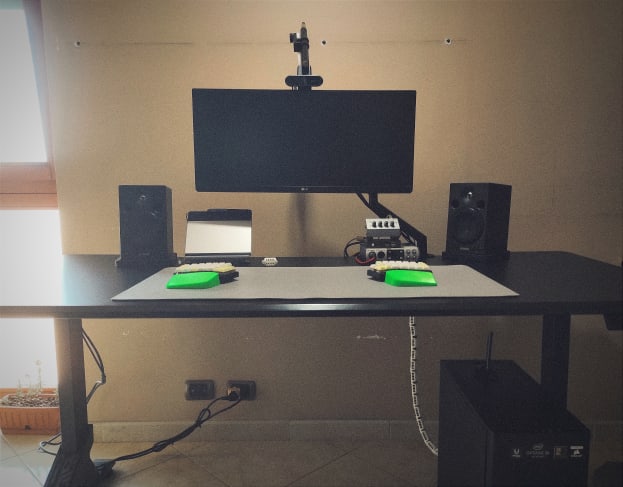Sasa!
The new year has already started and I must say I am really enjoying working from home and, moreover working as a freelancer. This gives more time for myself and my beautiful and ever-wonderful girlfriend, for my hobbies and to study a bit. When you save a solid 10 hours a week by slashing commuting time to and from the office, you collectively gain an extra week by the end of the month. A huge QOL improvement!
But everything comes with a price: you will start to notice all the flaws and defects of your space. One of the first problems I have encountered with my space is the cabling: a sort of spaghetti monster, built over months of carelessly and irrationally plugging and unplugging devices.
During my previous career, I learnt the importance of cable management through sweat and blood, because for a Sound Engineer ordered cables are everything. It sharpens efficiency: you can solve problems faster and you can finish your shift earlier. However, being a Developer makes the whole cable thingy less sensitive. That being said, spending the better part of your day in a cluttered space, with messy cables all over the places can lead to frustration very quickly and make you less focused on what really matters.
So the other day I woke up, and as I was looking at my desk, I swiftly decided that it was time for this insanity to come to an end.
As usual, I did my research about cable management and came to a single conclusion: cable management does not exist. Or better, there is not a single solution that can do the job. Cable management, for your home setup, is the application of different concepts and the use of different items. In the shops you can find all sorts of exotic devices that promise you the most rationale solutions, making you pay more than what you should for a bunch of plastic things, available at your local hardware store for a few coins.
If you are lucky enough to own a 3D printer you can also print some of the stuff to better suit your needs and your space. Otherwise you can also get the job done with some cable ties and plastic wrap which costs a few cents per meter.
The first thing to do in this case is to act radically and unplug EVERYTHING, since it is easier to start from a clean slate.

Then, you can mentally map out the kind of connections you need, and start to hook up the wires from your PC. The first item you have to physically place is you power source: gift yourself with a nice filtered multi-plug. You won’t regret it, especially during a thunderstorm. As you do so, to keep the job neat, wrap your cables with the system of your choice. In my case I have decided to use my 3D printed cable, as reminiscence of my times in the studio. While doing so, plan your length carefully: in case you use a motorized desk, consider the maximum extension you would require! You wouldn’t want your desk to pull your stuff, with the risk of damaging them.
Here is the stl of the cable sleeve I used: Modular cable management tube

After a myriad of plugging in and sticking stuff, I ended up having a sort of umbilical cord, with all the connections that my PC needed. It’s also worth considering that as I went up I started incorporating sections of cables that weren’t directly linked to the PC, such as the ones for the KVM, the audio cables going to my speakers and to my sound card, and the one going from my audio card to my headphones amplifier. A good strategy for me was to tie this bus to the clamp of the monitor arm with the help of a couple of cable ties.


Here take my piece of advice: avoid coiling cables too much and too tightly. Not ‘cause you’ll ruin the cables, but because by doing so you will make inductances, electrical components that will ruin the quality of your signal, introducing a good amount of disturbance, which for audio signals translates to an audible hum while, for digital signals, might translate to connection failures. Without digging too much into theory, while you can ignore reasonable coils for digital signals, you should avoid it all costs for power signals.
If you want to do things by the rules, and this is not the case, also avoid mixing power cables with signal cables. Now for the cherry on the cake for the audiophiles; a precious piece of advice I learnt from my former sound theory teacher, Roberto Tamburoni: when you are using a multi-plug, always populate it from the switch to the end, because in some specific cases the empty plugs might act as a resistances, introducing more disturbance in your system.
Now is the time for the power section. Here, I only had 2 cables. My strategy was to tie them on my desk’s leg at a point, leave a reasonable length free and then tie them down again, toward the main plug. Why this? To have a fancy-pancy, sexy curve long enough to accomodate the vertical extension of my desk.


Finally I can enjoy the end result! And yes, I am already looking for a solution to that back wall, and no, it won’t be paint. Don’t worry, sooner or later I will show you everything.

Happy building ⚒